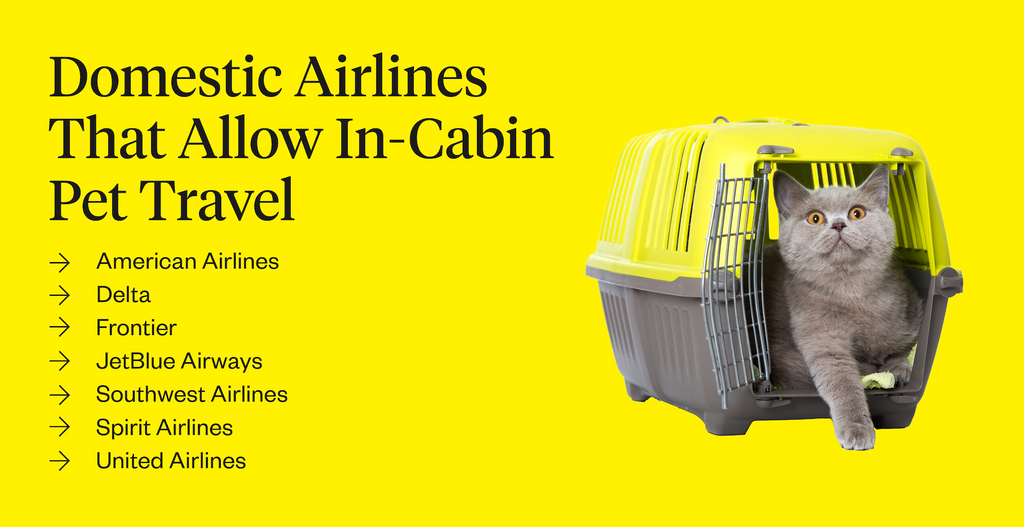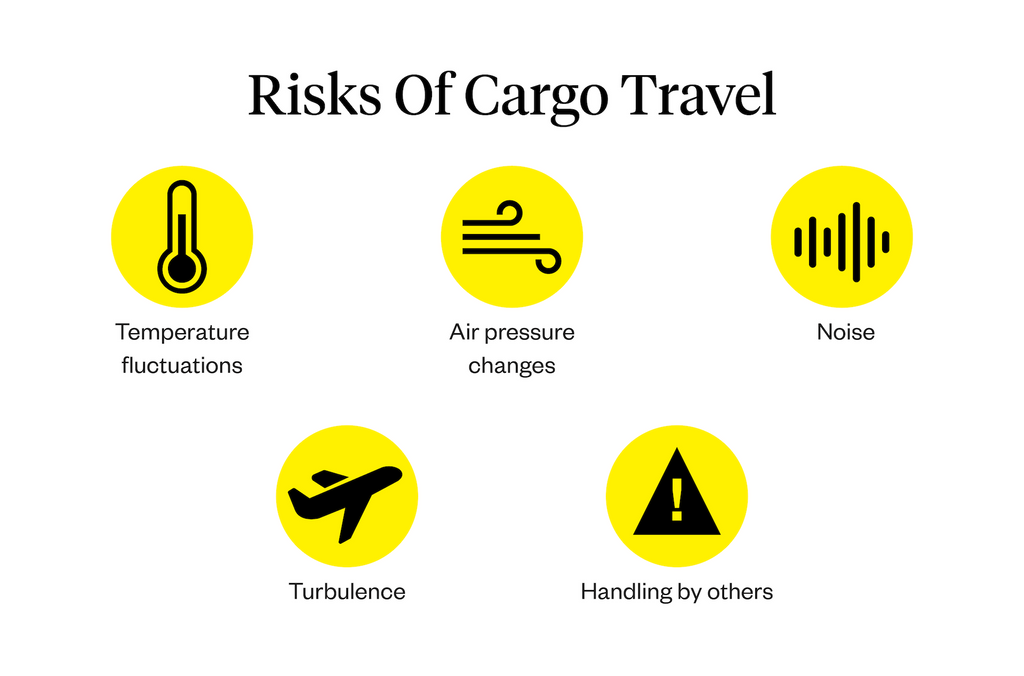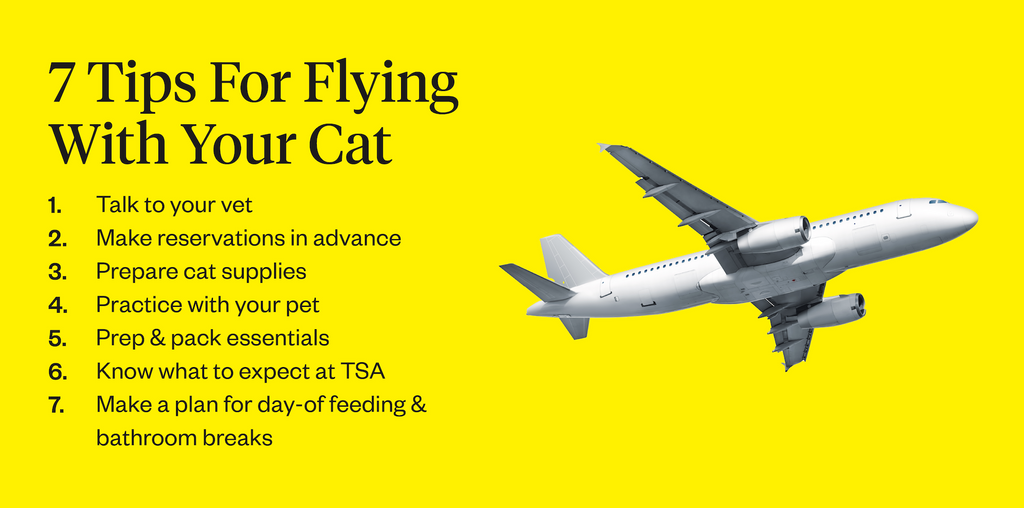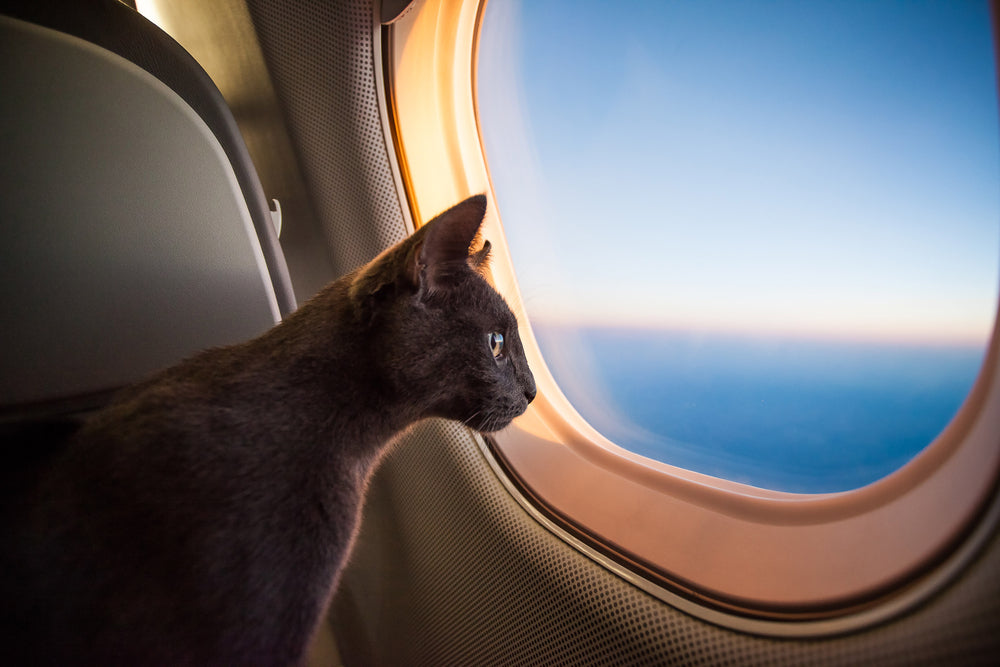15 Min Read
How To Fly With A Cat (Complete Travel Guide For Pet Parents)
Key takeaway

Why pet owners are switching to online vet care with Dutch
-
Prescriptions delivered free to you
-
Fast access to Licensed Vets over video
-
Unlimited video visits and follow-ups
Whether traveling for the holidays or going on vacation, you don't want to leave your cat at home. Though there are several options for pets while traveling, such as leaving them with a babysitter or asking someone to feed them and clean their litter box, many pet parents want to take their cats with them when they travel.
Whether you’re a human or a cat, traveling by plane can get a little overwhelming. If you're wondering how to travel with a cat, you've come to the right place. Whether you're wondering how to fly internationally with a cat or how much it costs to fly with a cat, we have the answers. This guide will discuss everything pet parents need to know about flying with their cats to ensure their pet's safety no matter where they're going.
- Can You Bring A Cat On A Plane?
- International Flights
- Risks Of Flying With Your Cat
- 7 Tips For Flying With Your Cat
- FAQs
- Final Notes

Can You Bring A Cat On A Plane?
Cats can fly on planes, but it depends on the airline and route. Fees for flying with your pet depend on whether they're flying in the cabin with you or as cargo. A few popular airlines that allow you to fly with your cat include:
- American Airlines: American Airlines allows cats to travel with you in the cabin. With American Airlines, you can only travel with one pet on flights up to twelve hours for domestic flights.
- Delta: Delta Air Lines allows small dogs, cats, and birds to travel with you in the cabin on a first come, first served basis.
- Frontier: Frontier Airlines allows small domestic pets of all kinds, including cats, dogs, rabbits, hamsters, and birds.
- JetBlue Airways: JetBlue allows two pets per person in separate carriers, but you must pay for a second seat if you want to bring a second pet. Unfortunately, they only allow small pets, and the cat's weight in their carrier cannot exceed 20 pounds.
- Southwest Airlines: Southwest Airlines allows small dogs and cats on flights for a fee.. Pets are not allowed on flights to or from Hawaii.
- Spirit Airlines: Spirit Airlines allows small domesticated cats, dogs, birds, and small domestic rabbits on flights for a fee.
- United Airlines: United Airlines allows small dogs and cats on flights for a fee, but like American Airlines, you'll face an additional fee if you have a long-distance flight with a stopover.

In-Cabin vs. Cargo
When flying with a cat, you have the option to have them in-cabin with you or transported as cargo. The safest way to travel with a pet is in the cabin with you. However, there are restrictions when flying with a cat in-cabin, including weight and size, and the restrictions may vary by airline. You'll also need a travel carrier for your pet, where they'll remain for the journey.
Pets can also travel as checked luggage if you're on the same flight. During the trip, they'll travel in the cargo beneath the cabin. Medium-sized pets typically travel as checked baggage, but most cats fall under the weight limit for most airlines, so your cat will likely be able to fly in-cabin with you. Still, you have the option of letting them travel as baggage. Unfortunately, there are several risks with cargo travel for cats, including:
- Temperatures: Cargo hold temperatures aren't regulated because luggage doesn't typically need temperature regulation. Many airlines have rules for when a cat can fly as cargo because of potentially dangerous temperature fluctuations. Unfortunately, since the cargo hold isn't properly regulated, crates can get too hot, causing dehydration in pets and the potential for death.
- Air pressure: Air pressure also fluctuates in the cargo hold. Cats can get scared or become ill from these fluctuations.
- Noise: The cargo hold is noisy, and cats are sensitive to sound. Sounds that aren't loud to you are extremely loud to your pet, especially in the cargo hold. With baggage constantly pushed around, the sound of luggage hitting their crate could make the situation even more stressful for cats.
- Turbulence: Turbulence is another concern because cats don't know what it is or why it's happening to them.
- Handling by others: Airlines typically have guidelines to keep pets safe, but you can't trust every handler to take proper care of your pet. In addition, humans loading luggage can forget pets on the tarmac during the unloading and loading process or forget to load them in the first place, resulting in missing and lost pets.
Even if everything goes smoothly when flying with a cat as luggage, it can cause extreme stress. Since you never want your cat experiencing anxiety, you should try to fly with them in the cabin whenever possible. It may be best to leave your cat at home with a pet sitter instead of taking them with you if you have to check them as luggage because they fall above the weight requirements of the airline.
International Flights
How to fly long-distance with a cat differs slightly from traveling domestically. Many airlines we discussed don't allow cats to travel internationally. However, there are a few that do. There are three ways to fly with a cat on international flights:
- In the cabin with you
- Book your pet a separate flight in which they'll be considered baggage
- Have your pet shipped through a commercial shipper as cargo1

Since most pet parents will choose to have their cats on the same flights with them, either in-cabin or as cargo, let's discuss a few international airlines that allow cats.
- Aeroflot: Aeroflot allows cats up to 18 pounds in the cabin, and you'll be subject to tariffs.
- Air Canada: Air Canada allows one pet per passenger for a fee that ranges from $59 to $118, depending on the destination.
- Air France: Air France allows one pet per passenger, but the cat must be 18 pounds or less, and the fee is $125.
- American Airlines: American Airlines allows one pet per passenger, and they can be up to 20 pounds. The fee is similar to domestic flights at $125.
- Avianca: Avianca allows one pet per passenger, but not from or to Europe. The fee is $130 when flying to or from the US.
- Delta: Delta allows one pet per passenger, but there are destination caveats. The fee varies, but you can expect to pay at least $200 outside the US.
- United Airlines: United Airlines allows pets on international flights with one pet per passenger. However, the rules for in-cabin pets vary.
This is not an exhaustive list, so it's important to do your research and call any airlines you're considering using when flying with a cat to learn about their pet policies and fees. In some cases, pets may need international health certificates provided by their veterinarian in order to fly outside of the United States.
However, most airlines allow cats to travel in-cabin with their human companions, but many restrict how many can travel with you. In most cases, they'll only allow one pet per passenger. Since each airline has restrictions on traveling with pets, you should contact the airlines to book your flight and have your questions answered to ensure your pet's safety.
Risks Of Flying With Your Cat
Flying with a cat can be risky, and if your cat can't travel in-cabin with you, it may be safer to leave them at home. When flying with your cat, always choose the cabin to ensure you can keep an eye on them and ensure they're not experiencing any stress. Flying with you will also prevent any potential dangers that can occur in the cargo hold.2
While many animals make it to their destinations without any issues while flying in the cargo hold, it can be a dangerous place for them. Many animals have been killed, injured, and lost when traveling by plane, especially since their pet parents won't be able to keep an eye on them once they hand over the carrier. In addition, because of the excessive temperature fluctuations and poor ventilation, the cargo hold is not the safest place for pets.1
If your pet must travel as cargo, always research your chosen airline to ensure they haven't had frequent animal incidents. You should be able to find this information on their website, but you can do other research and read reviews online to learn about other pet parents' experiences when flying with their pets.
Because the cargo hold can cause stress and be dangerous, you should always consider the risks for your cat. Always talk to a vet before you travel to ensure the cargo hold is safe for them. Some cats should never travel in the cargo hold, especially those with flat faces like Persian cats.2
In addition, your vet will be able to provide you with helpful recommendations for how to keep your pet safe when flying in-cabin or as cargo.

7 Tips For Flying With Your Cat
Flying with a cat doesn't have to be stressful, but if you're a loving pet parent, you'll likely worry about your pet's safety throughout the entire journey. Still, you can do a few things to prepare your cat for their flight, whether they're flying in-cabin or as cargo.
1. Talk To Your Vet
Weeks, or better yet months, before flying with your cat, you should have them examined by a vet to ensure they're healthy enough to travel. In addition, many airlines require a health certificate to travel, whether in-cabin or the cargo hold. Your cat must be up to date on all vaccinations, especially rabies vaccinations when traveling by plane.
Talking to your vet will also help you ensure your cat is healthy enough to travel. Some cats shouldn't travel, especially those that are ill or may experience severe trauma while in the cabin or cargo hold. Flying can be stressful for all types of cats, especially those afraid of people, other pets, or even their carrier. Whether they're in the cabin or cargo hold, they can experience serious cat anxiety.
In addition, before you leave, you should fill any of your cat's regular medications to ensure you have enough for your trip. Since vets are only licensed in the states where they operate (in most cases), they won't be able to call a pharmacy in a different state or country if you forget to fill your pet's medication or leave it at home.
Your vet will also discuss the potential risks of flying for your particular pet. But, again, some cats shouldn't fly. Whether they're suffering from a health issue or behavioral problems, flying might not always be best for your cat's health.
2. Make Reservations In Advance
Booking early is crucial if you want to fly with a cat. It also gives you enough time to familiarize yourself with the airline's pet policy so you can learn how to fly with a cat in-cabin, including what type of carrier you need, whether they'll have to stay under your seat the entire time, and what the weight limits are to ensure your cat isn't turned away when you get there.
Different airlines have different pet policies and requirements, so it's usually best to book over the phone since some may not have an option for booking your pet online. When you call the airline, they can walk you through the process and give you any additional information you need to feel confident when flying with your cat.
3. Prepare Cat Supplies
When flying with a cat, every airline will require you to use a pet carrier. However, the size requirements vary by airline, so you'll need to ensure you get the right carrier. A soft carrier is usually the most comfortable for pets but always check with the airline to ensure they allow both soft and hard carriers. In most cases, the soft-sided carrier is best because it allows your cat to move around more and may be more comfortable so they can nap while on the flight.
In addition, you should also bring other cat supplies, including:
- Lining for accidents: If your cat has an accident in their carrier, it's easier to pull out the lining and throw it away than it is to try to clean the carrier while your cat is still inside. If your cat has an accident, they won't want to spend the entire flight sitting in their own urine, so you'll need to have some way to clean it without potentially releasing your already-anxious cat.
- Comfort items: Airlines will require your cat to stay in their carrier for the duration of the flight, so you must make it comfortable for them. Since flying in a carrier can be stressful for pets, consider beginning some comfort items with you in their carrier. You can bring a favorite toy or blanket to help them feel more comfortable while traveling.
- Treats: Treats are also a good idea to have on hand to help your cat feel more comfortable. While your cat may be stressed, they can still experience some joy on a flight with regular treats given to them through the carrier to make the experience more positive.
- Food: Depending on how long your flight is or if you have a stopover, your cat may need to eat their meals while on the go. Bringing a small bag of cat food with you will ensure your cat never misses a meal.
4. Practice With Your Pet
If your cat doesn't have a carrier they're used to, you should consider getting them familiar with the carrier a few weeks before the flight so it'll be more comfortable for them. Let them rub up against it and explore it to learn more about it and get their scent on it. You can also leave the carrier open and allow them to freely go in if they feel like it. Once your cat is more comfortable with their carrier, you can put them inside of it for short periods of time and gradually increase how much time they spend in it to make them more comfortable during their travels.
5. Prep & Pack Essentials
While cat toys and blankets are optional, there are several things your cat will need. Even if you have a short trip ahead of you, you'll spend a lot of time in airports or traveling from place to place. Ensuring your cat never misses a meal and has water will ensure their safety and keep them on a semi-normal schedule to reduce any anxiety they're feeling. Create a packing list with the following items for your cat:
- Leash and harness
- Collapsible water bowl
- Treats
- Cat food
6. Know What To Expect At TSA
When going through airport security, your cat will need to be taken out of its carrier. Therefore, you should always have a collar and leash with an ID tag and ensure your pet is microchipped since they can easily escape at this point. The carrier will be put through the X-ray machine, and you'll need to maintain control of your pet.3
Your cat will go with you through the human screening device, so it's usually best to have a leash to ensure they don't escape since your cat may experience stress that causes them to try to escape or fight you as you hold them.
7. Make A Plan For Day-Of Feeding & Bathroom Breaks
Even though your cat will spend a few hours on a plane, they'll still need bathroom breaks and a chance to eat. Talk to your vet about the best way to space out feeding throughout the day, particularly if your cat is prone to motion sickness. In addition, plan how and when you'll feed your cat before and after the trip. It's usually best to try not to deviate from their existing routines because it can exacerbate anxiety, so planning accordingly can be beneficial and reduce stress for both of you.
FAQs
How much does it cost to fly with a cat?
How much it costs to fly with a cat depends on the airline you choose. But, how much is it to fly with a cat? Most pet parents can expect to spend at least $100 to fly with their pet in-cabin. In addition, it may be more costly to fly internationally with a cat, so always do your research and check with the airline to understand any associated costs and fees.
Is flying painful for cats?
Flying can be painful and scary for cats. The change in pressure and altitude that causes your ears to pop can cause ear pain in cats. In addition, flying in the cargo hold increases the chances of them getting hurt by luggage that slides into their carriers if it's not secured properly. Flying in-cabin is often the safest way to travel with your cat and allows you to comfort your cat by talking to them or petting them through the carrier when they experience stress.
How do I get my cat to stop meowing on a plane?
Cats meow on planes for many reasons, but they're most likely trying to tell you they're stressed. If your cat is excessively meowing, it likely indicates stress or fear, so you should do everything you can to try to make them feel more comfortable. If you're worried about your cat experiencing stress or your cat is restless on a plane, you can talk to your vet, who can prescribe short-term anxiety medication to treat cat anxiety and improve their experience while flying.

Final Notes
Traveling with a cat can be stressful for both of you. Always take the proper precautions and learn as much as you can when taking your cat on a flight. It's always best to pay for them to fly in the cabin with you to ensure their health and safety. Unfortunately, even when flying under your seat or on your lap in their carrier, cats can experience stress. If you're worried about traveling with your cat or have any questions, talk to a Dutch vet. Dutch offers telemedicine for pets to treat anxiety and other health problems. Try Dutch today.Share
References
-
"Pets and International Travel - United States Department of State." US Department of State, December 2 2021, https://www.state.gov/pets-and-international-travel/.
-
"Travel Safely with Your Pet by Car, Airplane, Ship or Train." The Humane Society of the United States, https://www.humanesociety.org/resources/travel-safely-your-pet-car-airplane-ship-or-train#.
-
"Small Pets." Small Pets | Transportation Security Administration, https://www.tsa.gov/travel/security-screening/whatcanibring/items/small-pets.
